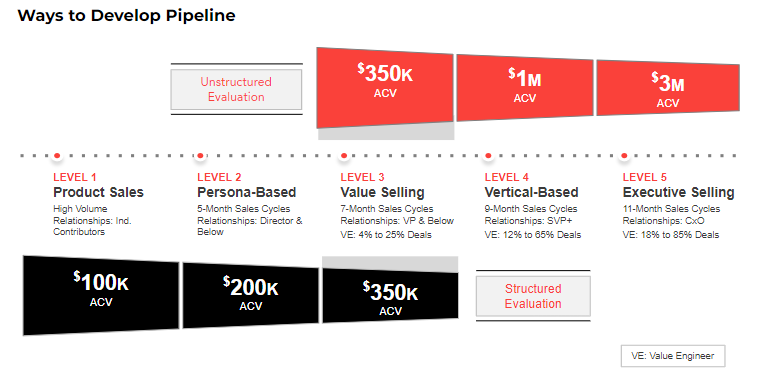C-suite engagement might be the secret to your success in enterprise sales. Executive buy-in can help ease purchasing scrutiny and indecision (particularly critical in a budget-conscious economy). And when executives see you as a strategic partner, you’re far more likely to push deal sizes from the hundreds of thousands to the millions.
What Is C-Level Engagement?
C-level engagement is the process of aligning your solution to the key business objectives of c-suite executives, so you can drive strategic relationships at the highest levels of an organization (i.e., CEOs, CFOs, CIOs).
Why C-Suite Executives Are Difficult to Reach
C-suite selling is easier said than done. By virtue of their positions as key leaders, executives are notoriously difficult to engage. Why?
- Because they’re hounded by dozens of sellers and marketers every hour—so many executives have dedicated personal assistants and established guidelines to filter out the noise.
- Because executives need to focus more on the bigger picture—so they often delegate tasks like purchasing evaluations to their teams.
- Because they’ve already come up with a plan for where they want to steer the company—so they think they know what they want (or need) to get there.
That being said: The best sellers know how to find the “unknown unknowns” of executives and earn real conversations with them.
How Elite Sellers Earn C-Suite Engagement
Conventional wisdom tells us that you get to the enterprise executive at the end of the sales cycle, after you’ve reached out to dozens of prospects lower on the corporate ladder and built up champions. We consider this a “structured evaluation.”
This still works to some extent, but it’s a process that’s become slow, bloated, and tired. More importantly, it usually leads to smaller, less strategic deals—because you’re waiting till the end of the deal process to bring in the executive with the power to think bigger and longer term. And because you have to jump through so many hoops just to get going, your conversion rate is usually about 1 in 5.
Elite sellers understand that the key to success in enterprise sales is simple: Don’t follow the old rules if you’re expecting a different result. Conventional processes naturally lead to conventional results, so if you want an exceptional outcome—like achieving 185% of your quota, for example—you need exceptional thinking. In other words, you need to step into uncomfortable territory to get the bigger payoffs.
Get uncomfortable and enter “unstructured evaluations.” Engage with the executives directly.
Prime Your Pipeline for Quality Over Quantity
Structured evaluations follow the conventional sales motion, while unstructured evaluations are necessary to find larger, more strategic deals at an enterprise level.

With today’s current market, companies are more resistant to the structured sales motion than ever before. They know what to expect, so they know how to block sellers and marketers from connecting with them.
This opens the door for sellers to get creative. Going outside the usual processes allows you to cut through the noise and engage c-level decision makers who are more willing to invest in new solutions that deliver highly relevant value.
Let’s look at what’s at stake if you’re stuck in structured evaluations with these hypothetical numbers:
- According to Hubspot, the average close rate in the software industry is 22%.
- Then, compare that to your patch. How many companies want to buy your solutions in a structured evaluation today? For this example, let’s say that’s around 1.3x your quota.
- If we combine those two numbers, that says you will only be able to achieve about 29% of your annual quota.
- In summary, your opportunities across your entire account base need to be over 4.5x your annual quota to hit your targets.
I recommend swapping in your own close rates and pipeline opportunity numbers to see the cost of staying in the structured evaluation comfort zone. In a world of savvy buyers and widely available product information, can you exceed—or even touch—your quota this way?
The good news? This opens the door for sellers to get creative. Going outside the usual processes allows you to cut through the noise and engage c-level decision makers who are more willing to invest in new solutions that deliver highly relevant value.
Want more insight on booking c-suite meetings? Try our Data + Emails = Meetings video series.
How to Engage C-Level Executives
Okay, so you know why it’s so hard to get executive engagement and that elites are selling to the c-level by entering unstructured evaluations… but how can you get started?
Understand the C-Suite Agenda
Sellers who are well-versed in their prospect’s c-suite agenda are able to answer these questions:
- What are the top strategic priorities of the c-suite executives? What are the key financial goals and metrics that the c-suite aims to achieve?
- How does the c-suite view their industry's future trends and challenges? How do they assess their market positioning?
- Has the c-suite implemented any major initiatives or projects to address these priorities?
- How does the c-suite define success and measure the effectiveness of their initiatives?
- What is the c-suite perspective on innovation, technology adoption, and digital transformation within their industry?
- Is the c-suite exploring any technological solutions, and what are the consequences of doing so (or not)?
If you cannot answer these questions, you either won’t get a seat at the table, or you’ll be forced to close smaller deals.
Don’t like research? Sorry. It’s a must for strategic selling, particularly to the c-suite. There’s good news, though. Most of the answers can be found through online searches of investor and financial reports (for publicly traded companies), or—even faster—through the use of a Strategic Relationship Management platform like Databook.
Personalize Your Deliverables
Try looking at things through the executive’s perspective. They don’t really care about how your solution works. They care about what results your solution brings forward, how those results impact the company’s performance, and—more specifically—how those results impact their own OKRs. Remember, your job is to de-risk the project. Prepare deliverables designed to show executives how you’ll help meet objectives.
Some tips to remember that help convey value:
- Demonstrate a financial case for change—why investment into your solution specifically will help them achieve their goals.
- Share how your other customers have gained a new competitive advantage through the improved efficiency your solution brought them.
- Provide executives with a point of view on their business that is relevant, impactful, and concise.
Ready to supercharge your sales process? Download free email templates proven to engage executives on their level.
Come at the Deal from All Sides
Elite sellers understand how to multithread at an executive level. Make sure you are managing two key motions at the same time:
- Connect with the prospect’s evaluation team through the usual structured process, and
- Develop outreach your own executive team can use to connect with the prospect’s c-suite.
Additionally, make sure everyone in your GTM team (client success, marketing, finance, etc) is aligned on expectations, standards, due dates, and next steps. Your team should have a point of view on your prospect’s business, and understand how to communicate that information.
Make it Repeatable
The executives you speak with value their time highly. The fastest and most reliable way to secure their investment is to come forward with a compelling case for change that is backed by metrics. Don’t fall into the trap of thinking your time isn’t as valuable as theirs. Track what works and execute with a regular, documented cadence that includes every step of the sales cycle, from account planning to crafting proposals. Build scalable, repeatable methods for c-suite sales so your team can get larger deals across the finish line, faster.
Remember: Time Kills Deals
Time is a merciless opponent, especially in enterprise sales. Executives are always on the move, always thinking about the company’s next strategy, and are always—always—being contacted by other sellers.
If you aren’t selling to the c-suite, someone else is.
The faster you can understand an executive’s needs and propensity to buy, the faster you can personalize your c-suite engagement and stand out from the crowd.
Strategic Sellers Engage Execs
If you’ve struggled with c-suite engagement in the past, it’s time to change that. As you gear up to become a more strategic seller, working these motions will become second nature to you. And if you need help, we have resources galore available within the Strategic Sales Network, from forum discussions to templates and videos. Join today to start ramping up your executive selling game.
